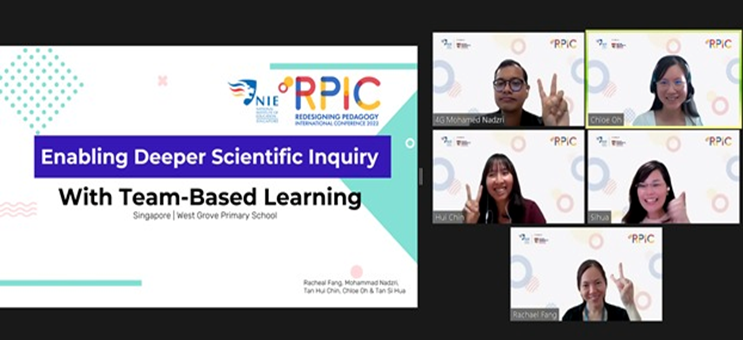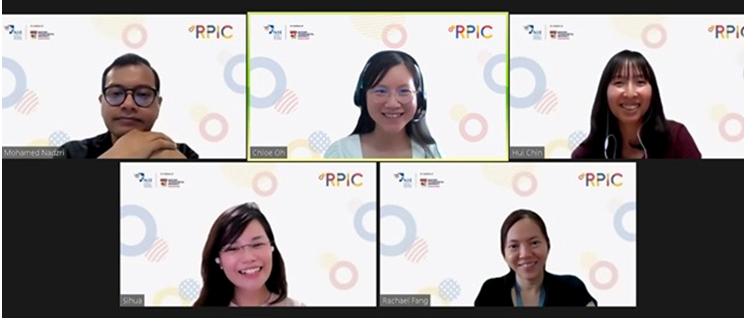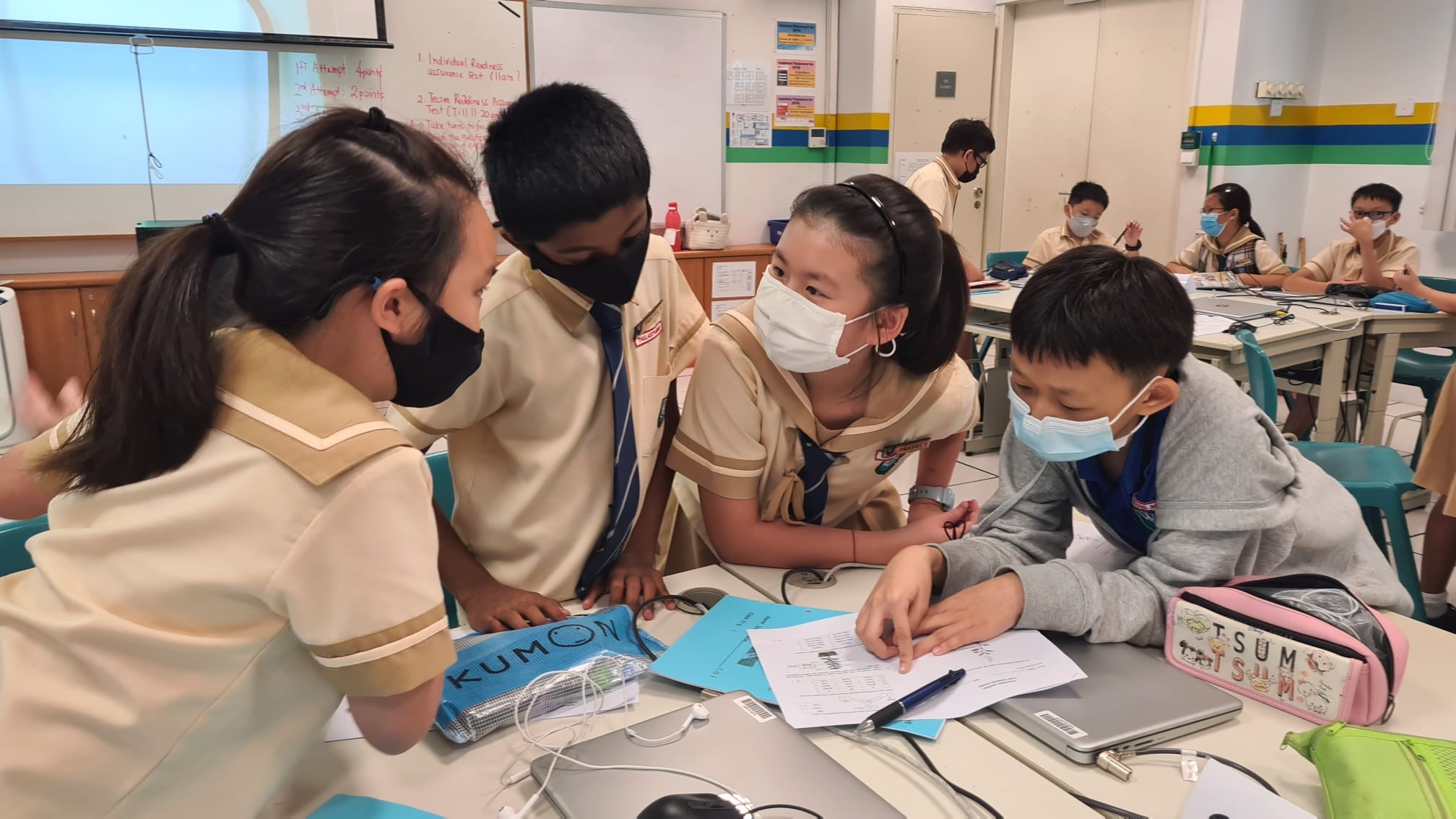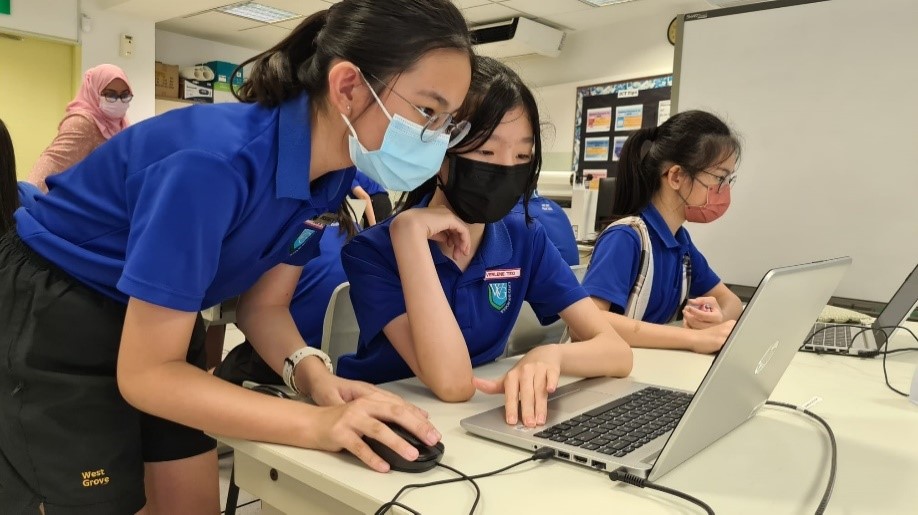Why Singapore’s English Teachers Should Embrace Singlish, Not Fight It
Is it time for Singaporean educators to embrace Singlish as a legitimate learning tool? What the Research […]
Read More
Contributed by Tan Si Hua, Rachael Fang Swee Sian, Chloe Oh Wan Ling, Mohammad Nazdri Md Nasir and Tan Hui Chin from West Grove Primary School, for SingTeach Virtual Staff Lounge


The team comprises (from upper left in clockwise direction) Mohammad Nazdri Md Nasir, Chloe Oh Wan Ling, Tan Hui Chin, Rachael Fang Swee Sian and Tan Si Hua.
To prepare our young for the VUCA world, science educators around the world are exploring deep learning pedagogical approaches and technological affordances to promote 21st century competencies (21st CC) and deepen scientific inquiry (Freeman, Becker, Cummins, Davis & Hall Giesinger, 2017; Pohl, 2001).
Flipped team-based learning (flipped-TBL) is a technology-enabled pedagogical approach that provides opportunities for students to engage in deeper scientific inquiry and develop 21st CC, specifically self-directed learning (SDL) and collaborative learning (CoL) in science classrooms.
Flipped-TBL combines the merits of the “flipped classroom”[1] (Truss, 2011) and the team-based learning[2] model (Michaelsen, 2009). The flipped classroom creates more space in the curriculum for deeper scientific inquiry and provides students with the autonomy to direct their learning. The team-based learning model, originally developed within the context of higher education, promotes CoL and accountability in learning.
Flipped-TBL comprises five key stages (Figure 1). In essence, students will access online content and come to class prepared to engage in deeper and more meaningful discussions. Students will go through a specific sequence of individual and group learning activities to apply their learning through higher-order problem-solving.

Figure 1. Flipped team-based learning framework.
The first stage of flipped-TBL provides students with preparatory materials, such as online videos and articles, to review before the science topic is raised in class. These materials highlight foundational and key concepts that students are required to acquire for the topic. Technology affordances are tapped upon to promote students’ SDL by scaffolding their concept acquisition and monitoring their learning. For example, a quiz tool like Edpuzzle allows teachers to embed questions and prompts in videos to direct students’ thinking and assess their conceptual understanding. Students are taught strategies like pausing the online videos at different points to review the content and take notes to manage their learning pace.
At this stage, teachers will use data generated from students’ online learning to monitor their progress and further calibrate the pace of subsequent learning experiences. To further support students in managing their pace of learning, teachers will also intentionally teach students strategies like pausing the online videos at different points to review the content.
The following three stages of flipped-TBL serve to hold students accountable for acquiring key scientific concepts from the pre-class preparatory materials so that they can contribute productively to in-class group discussions. Besides completing a short test of multiple-choice questions individually to determine what students understand from the preparatory materials, students also have to complete the same questions with their group members. Through negotiating with their team members, students explore possible answers, deepening their understanding of the topic.
During these stages, teachers take on the role of facilitators. Using questions, teachers scaffold students’ thinking. At the same time, teachers take note of the learning misconceptions that surfaced during the group discussions. At the end of the discussions, teachers will sum up students’ learning by addressing students’ learning gaps and providing opportunities for students to share their understanding.

Figure 2. Students working collaboratively to finalise their answers on the Immediate Feedback Assessment Technique (IF-AT) “Scratch and Win” cards.
During the last stage of flipped-TBL, students will work collaboratively on a higher-order problem-solving task to apply the scientific concepts they have learnt.
For example, in the learning of energy in the primary school science syllabus , students take ownership of their learning by researching how Singapore and countries around the world obtain energy. In groups, students are tasked to establish criteria and evaluate appropriate methods for Singapore to harness and conserve energy, considering Singapore’s environmental, economic and physical factors and consequences such as sustainability, feasibility and costs.
Beyond learning about different forms of energy and how they can be converted from one form to another, students also learn about the importance of energy and energy conservation. Students have the opportunities to examine their values and develop critical scientific process skills such as decision-making when they explore alternative energy and trade-offs.

Figure 3. Students working collaboratively to learn how Singapore and countries around the world obtain energy.
This technology-enabled pedagogy has led to the school witnessing a shift in students’ roles – from passive recipients of information to one of active learners leveraging technology to take charge of their learning. Our findings suggest that students have demonstrated a good extent of SDL and CoL. Flipped-TBL, which promotes inquiry and problem-solving, lends itself particularly well to science teaching and learning. With more space and flexibility in the curriculum, students can explore deeper concepts and draw connections between classroom learning and the real-world context, fostering the joy of learning. In flipped-TBL, the role of teachers has also evolved from a deliverer of content to a designer of the overall instructional process.
References
Freeman, A., Adams Becker, S., Cummins, M., Davis, A., and Hall Giesinger, C. (2017). NMC Horizon Report: 2017 Library Edition. Austin, Texas: The New Media Consortium.
Michaelsen, L. K., & Sweet, M. (2008). The essential elements of team-based learning. New Directions for Teaching and Learning, 2008(116), 7-27.
Pohl, M. (2001). Learning to think, thinking to learn: Models and strategies to develop a classroom culture of thinking. Cheltenham, Australia: Hawker Brownlow Education Pty Ltd.
Truss, D. (2011). 3 keys to a flipped classroom. [web log message] Message posted to http://www.connectedprincipals.com/archives/3367
[1]A flipped classroom is one where teachers “flip your instruction so that students watch and listen to your lectures… for homework, and then use your precious class-time for what previously, often was done in homework: tackling difficult problems, working in groups, researching, collaborating, crafting and creating” (Truss, 2011).
[2]Team-based learning is a special form of collaborative learning using a specific sequence of individual work, group work and immediate feedback to create a motivational framework in which students increasingly hold each other accountable for coming to class prepared and contributing to discussion (Michaelsen, L., & Sweet, M, 2009).